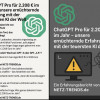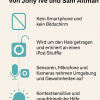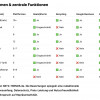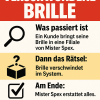
“Google News” Germany from a Practical Perspective
Google has completely redesigned its news portal Google News. With a new lean design, better readability, and a fact check function, Google wants to make it even easier for its users. But does the new Google News really live up to its promises? Netz-trends.de did the practical test.
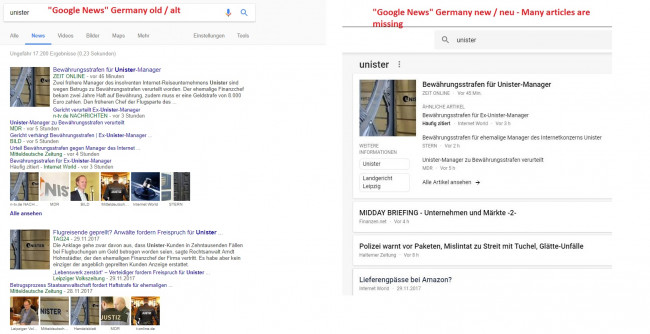
The Google News redesign introduces a complete new layout, transitioning its 14-year-old news reader into a card-based interface. The central element of the new site are the so-called "story cards". They are more or less limited to just three elements: title, medium and date of publication. Google also deleted the so-called snippets that used to be under the title of an article.
But even though Google certainly meant well its modernization path, in many ways the layout looks half-baked. Besides, the hit rate of the new Google News is a disaster.
Google's radical transformation for its news aggregator
What is Google’s motivation for the new design? The fact is, the new Google News is unfortunately a step beckwards regarding search quality and hit rate. Google is miles away from its original aim to be a broad-based news aggregator, covering a wide range of media from established news magazines to smaller special interest blogs.
Information about the new Google News can be found on Google's own blog post, which was published at the same time to the relaunch of the site. Here, the US group explains at least partly why they have changed the new Google News.
Regarding the fact that in the new Google News only the headline of the article is shown instead of a snippet, Google claims that this has been introduced in favor of readability. According to Google, the new story card format should make it easier for readers to search for articles and to check their relevance. Aha! But: Of course it brings the reader more, if he gets in addition to the title at least two or three lines in Google on background information like it was used to be in the old Google News.
Google has also revised the navigation bar, which is located on the left side. The navigation bar allows the user to filter news according to specific areas of interest. By default, the topics economics, knowledge, sports, entertainment and national and international reporting are preset.
The selection can be tailored to the user’s needs. If one likes to google "NASA" or "Apple", he or she can easily create an own news area. For this function, however, Google asks for a Gmail account; data snooping might be included! And: Google is taking a step towards a closed Internet structure. It is a kind of an unpleasant reading barrier. Does it contribute to good user experience? Definitely not!
Top headlines are now called "Story Cards"
The most striking feature of the new Google News are the so-called "story cards". They replace the old search results and contain the title of the message, a photo, and possibly a video. In general, Google seems to want to give more space to moving images. According to Google’s blog, news videos would become increasingly important and therefore the company improved the Google algorithm.
Concerning the selection of the "story cards", Google wants to look for a balanced view from different perspectives. Furthermore, the company implemented tags such as "frequently quoted", "local source" or "live update" in order to increase the trustworthiness of the news aggregator. For now, the fact check label of the new Google News is only available for the US users. The fact check label includes all search results that have been checked for accuracy by one of the 115 Google cooperating organizations, such as PolitiFact and Snopes.
Search engine with massive vulnerabilities
But how exactly does the new surface work? After all, the US Company has always been committed to user-friendliness. Netz-trends.de is interested in one thing: Does Google News deliver high quality search results? (All the following information is only for a quick test in the Google News Desktop version in the browser's Incognito mode).
Our research is based on several exemplary selected samples from the sections economy, politics and sport from Friday, July 7, 2017. The first test was carried out with the keyword billiger.de, a large German price comparison website. After entering the keyword, the new Google News listed a colorful collection of "Story Cards", while the ranking seemed to be somewhat arbitrary.
The first entry is the headline "Billiger.de: Grippostad as top deal". The headline comes from the pharmaceutical news blog Apotheke Adhoc. Since this is the most recent news article on billiger.de, the ranking of this article makes sense.
The second article about billiger.de seems to be much more problematic. The title of the article on finanznachrichten.de is: "The view of the Raiffeisen Chief Economist: power of the future". A connection between the search query "billiger.de" and the Raiffeisen bank is not initially apparent to the reader. Where once you have once found some brief information about the headline in the so-called snippet, you now have to click through each article individually. A real flaw in the new Google News.
Another big drawback: Under the keyword billiger.de, Google also shows a terrifyingly long series of irrelevant articles. In particular, numerous articles from the Germany company T-online appeared in the list, although they are not even addressing billiger.de. The reason for this can be found quickly. Since billiger.de is shown on the T-Online page as a partner network, Google seems to incorporate this link into the results. Here, the US company still urgently needs to improve the search algorithm.
The new Google News also seems to have only a very weak memory. According to our research, only articles are displayed which are not older than 2 weeks. But that's not all: The number of articles also seems to have been cut down significantly by Google News team.
Apparently, Google does not care about older news and articles. A look back in history is not possible anymore. Thus, the value for the user drops dramatically to zero. If you want to read older news on a specific topic, you have to cumbersomely use the Google archive. Unless you find it at all - which in most cases we have tested was not the case.
For example, in our short test run on Friday the 7th of July 2017, we searched for the keyword "Unister" in the new Google News. Unfortunately, the new Google News only found two articles, although Unister was a multimillion dollar company in Germany. In addition: The town show articles were quite irrelevant to the readers.
The first article was a general one around the travel market ("The margins are underground in the travel market" by Internet World on 28.06.2017). The second article about Unister was published by Skift in English (a portal that plays no role in Germany) with the title: "Lastminute.com Group CEO: We Consider Ourselves a Media Company" (also from 28.06.2017 ).
No results for the hundreds of articles on the dramatic plane crash of Unister founder Thomas Wagner a year ago. No match to the lawsuit, where a fraudster who lured Wagner into a financial trap and facilitated 1.5 million euros. Google News does not even offer news bulletins on a month-long legal case against three Unister managers
The earlier version of the news aggregator was much more powerful here. Also, the user interface in the old Google News was much more comfortable and covered a longer time period.
During our second test run, the news aggregator delivered much more useful results under the keyword "1. Bayern Munich". Ranked by publication date, the user can find numerous messages about player transfers, coaches and football results. Reports from regional media, such as Süddeutsche Zeitung or TZ, are marked with the tag "Local Source". The new Google News has also summarized thematically identical articles in a story card.
The new Google News prefers established media over small news blogs
An exclusive short sample survey of the news portal netz-trends.de on July 7, 2017 also showed that the Google News search algorithm prefers the large media, even if they only spin down dpa or reuter headlines.
50% of all 75 home page articles in an international issue of Google News, "Google News USA," went down to just 17 at 7:15 pm on July 7, 2017, at the time of our sample. In doing so, we did not consider possible further articles that only show themselves to the consumer by clicking on submenus.
Among the dominant 17 media on Google News USA, which shared 50% of the articles on the first Google News page, were almost exclusively US-based media, which in almost all cases have been dominating the opinions and information in the US. At the time of our sample, these were:
Washington Post, CNN, Fox News, New York Times, BBC, Bloomberg, Hollywood Reporter, The Hill, Twitter, U.S. News & World Report, ABC News, Bleacher Report, CBSSports.com, Chron.com, Daily Mail and the Endo Pharmaceuticals.
The remaining 50% were 38 media. Again, we could almost only find old media classics. Among them there were also international ones with a broad political spectrum, which increased the usefulness of Google News slightly:
ESA, PolitiFact, Fox Business, From Australia The Australian, From China Xinhua, From India Firstpost, From Russia The Moscow Times, GoFundMe, Haaretz, Halo Waypoint, HNew York Post, Los Angeles Times, Marvel.com, Miami Herald, New York Daily News, Newsweek, Newsy, Opinion Los Angeles Times, RED camera, Reddit, Science Advances, Scientific American, Smartphone business news, Telegraph.co.uk, The Verge, The Verge, The Weather Channel, TIME, TMZ.com, United Kingdom Daily Star, University of Edinburgh, VentureBeat, Wall Street Journal, WANE, World Health Organization, WPXI Pittsburgh, YouTube and ZDNet.
In our test run, Google News USA preferred the following media on the Google News USA homepage, which means they're collecting the bulk of hundreds of thousands of user clicks, and thus ad revenue.
Washington Post (5 articles in Google News USA auf der Startseite), CNN (4 articles in Google News USA on the front page), Fox News (4 articles), New York Times (4 articles), BBC (2 articles), Bloomberg (2 articles), Hollywood Reporter (2), The Hill (2), Twitter (2) und U.S. News & World Report (2).
Google News Germany underpins monopoly position of the largest German media companies
An even darker picture in terms of pluralism of opinion emerges for the homepage of Google News Germany. At the time of our test run on July 7, 2017 at 16:10 clock, 64% of all 47 front page articles in Google News were publishes just by 8 media houses. Articles that only became visible by clicking on the submenu were not included.
Above all, the established German media, which have been influencing the public opinion long before the Internet revolution, rank among the top 8. With a total of 8 articles Focus Online leads the ranking, followed by Welt Online (6 articles), Spiegel Online (4 articles), Bild.de (4 articles) as well as 2 articles by NDR.de, Stern.de, Sueddeutsche.de.
Such a preference to Focus onlineand Welt.de is extremely strange. For example, in two test runs around 17% of the articles on the Google News Germany front page were published by Focus online (see tables).
The other 36% were distributed across a total of 16 different media. In addition to very well-known brands, such as t-online.de, n-tv.de and RTL Online were also smaller blogs, such as golem.de and heise.de, under the search results. In addition, Google also included some special interest sites such as finanzen.net, chip.de, heilpraxis.net and playstation.com on the Google News front page.
But it is also clear that news from politics and business are determined by the top dogs. Google's much quoted “all-round view” on a subject remains under investigation. All Google traffic is distributed in only a few media for both Google News USA and Google News Germany.
The almost monopolistic position of individual media houses on the Google News front page is even more dramatic than in the United States of America. 64% of all articles in Germany come from only 8 houses at the time of the Google News test.
On July 10, 2017 at 11:25 a third test run took place. Again, almost the same news sources dominated as on Friday. Right up front was Focus Online with 8 articles. Spiegel Online was listed by Google News Germany with 5 articles, the pages of Zeit Online, Sueddeutsche.de with 3 contributions each. Welt Online was present with two articles.
If one takes the news portals from last Friday as a new calculation basis for the distribution, then approximately 53 per cent of the articles displayed on the start page on Google News Germany come from the eight major news houses Focus, Spiegel, Zeit, Süddeutsche, Welt, Bild, Stern and Frankfurter Allgemeine Zeitung. The NDR did not occur in this test run.
The remaining 47% on the homepage of Google News Germany are based on reports from 18 different editors. To a large extent, however, the US group also lists the blogs and news portals already collected in the first investigation, such as heilpraxis.net, golem.de, playstation.com and chip.de.
Although Google News Germany took up to over 700 news sources, the front page contains mostly headlines and news from only a few media houses.
On the other hand, it is exemplary that Google News increasingly uses foreign specialist media for foreign policy issues. Worth mentioning here are the portals euronews.de, ostexperte.de or the Austrian news magazine kurier.at. News with nationwide relevance, but researched locally are labeled with "Local Source".
To draw the conclusion: The huge media companies get the Google traffic on news and thus the entire sales, whereas independent and smaller blogs are suffering. As a result, the Internet is becoming increasingly monopolized in the field of news. Yet the internet was supposed to be a broader democratic base, where many people of the most varied proportions have their voice - not the only the top dogs, who already share the talk show rounds in ARD, ZDF or BBC.
So in the end, Google only promotes the big ones, which is contrary to Googles inception in 1998 where it has sworn not to do so. For the user, Google’s new news algorithm is a step backwards. Instead of diversity of blogs and media, Google delivers more and more uniformity.
Search engine optimization reduces journalistic quality
In addition, Google prefers all the big companies, which put hundreds of millions of euros in search engine optimization (SEO) and other search techniques: We estimate that this should include, for example, welt.de and some other suspects.
These portals drive for years their search engine optimization (SEO) on the top, in which some texts are simply provided with a different headline or easily rewritten in order to get top position in Google News. Smaller blogs cannot afford an extensive SEO optimization.
Independent Internet magazines and news blogs or opinion blogs are thus losing more and more ground and opportunities.
Google News does not (yet) convince
Login compulsion, missing snippets, poor info, illogical news selection, too little media variety in the hits on the Google News homepage: The list of criticisms of the new Google News is long. Google should have done more with its relaunch of Google News than only cosmetically changes.
This means that the few advantages of the new Google News, such as the new "Story Cards" or tags (which almost look old-fashioned again), do not outweigh the numerous disadvantages.
Another big disadvantage is that personalized news area and archive is only accessible with a Google Gmail registration.
Update from July 11, 2017:
Another point of criticism: Google News Germany is misleading with the "All articles" button. In fact, Google News does not list "all" Google News articles, just a very small selection. So far, nobody knows on what criteria this selection is based.
In any case, the quality of the texts cannot be the criterion. Articles of daily newspaper publishers also appear in their online appearances, which in turn often tend to duplicate content due to agency news. One current example: If you search for articles about recipients of Hartz IV, you’ll find only a small selection of articles. For example, there is a lack of news with the keyword "Hartz IV unemployed". The most recent article "More and more long-term unemployed with Hartz IV" from the blog steuerratschlag.eu did not show up at all.
The same applies to the keyword "Unister": In this netz-trends.de article, we have mentioned the large East German Internet company Unister, which went into bankruptcy after the death of its founder Thomas Wagner, several times. While in the old Google News Germany our article is listed under the keyword "Unister", it is missing in the new Google News Germany (or Google News Germany) completely. Google needs to improve its algorithm at this point.






